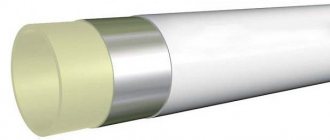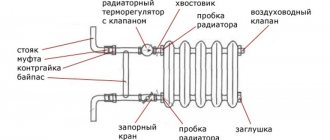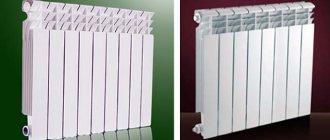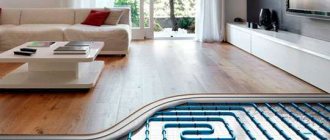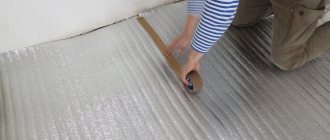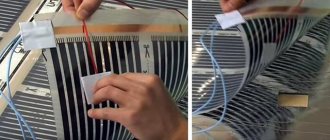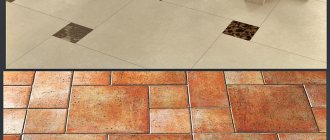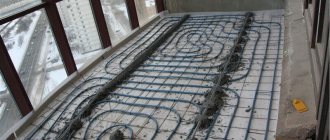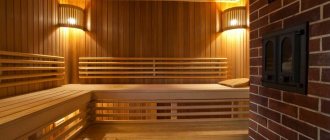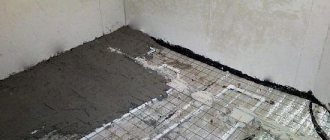Does the warm floor under the furniture warm the room?
It turns out that if you do not lay pipes under the furniture, the area of the heating surface of the floor will be too small to heat the room.
What if you also have carpet on the floor? Okay, no carpet. Then, in order to heat the room, you will have to increase the floor temperature. But it will be unpleasant to walk on it. You can also compensate for the lack of heat with a radiator battery. But this is much more expensive than the pipe that was not laid in the floor. Friends, who said that branches covered with furniture will not provide heat?
Not at all. Heat from the floor screed will be transferred to the walls. In this case, the walls begin to radiate heat into the room, and not vice versa, cooling the air in it.
Underfloor heating project
It is necessary to determine the size of the heated area. Draw up a schematic plan of the room. Mark on it the size of the kitchen set, refrigerator, other household stationary equipment and furniture. There is no “warm floor” installed underneath them.
- 30 cm away from the interior.
- From the walls that remain free, make a 15 cm indent.
- Apartments in the city are heated by radiators. Floor heating is installed at a distance of 15 cm from the appliances.
- The heated surface makes up 70% of the total active area of the room.
When choosing electrical systems, the consumption rate for the kitchen area is taken into account. If underfloor heating is used as the main heating, then the power must be at least 150 W/m2. If the system is installed for additional floor heating, then the optimal power is 120 W/m2.
When using cable sections or a liquid line, it is necessary to determine the length of the circuit and the laying pitch.
- For liquid heating, a cross-linked polyethylene pipe is used, which is made using peroxides.
- Diameter 16 mm.
- If the laying step is 15 cm, then 6.7 m of pipe will be needed per 1 m2.
- At a coolant temperature of 30 0C, the floor temperature will be 18 0C. When the thermal temperature of the liquid is 33 0C, the floor will warm up to 22 0C.
We recommend: How to choose a thermostatic valve for underfloor heating?
The power of the cable section is calculated depending on the size of the active area. To heat 10 m2 you will need 1 kW of energy. Select the appropriate section. The length of the cable in it is determined by the manufacturer. Laying is carried out in increments of 10-15 cm.
Mats, carbon rods and thermal film are chosen with a power of 150 W/m2. It is recommended to make a pattern for laying the main line, film or mats. Markings are made on it on the base of the floor, which will facilitate installation work.
The main wiring in the house needs to be tested. Its power must correspond to the energy consumption of the “warm floor” and all household items that operate on electricity. Otherwise, when connecting underfloor heating, the network will not cope with the high load; there is a risk of an emergency.
If the kitchen area is 20 m2, then the heated surface can only be 10 m2. The heating system will require an average power of 1 kW. A pipeline with a diameter of 16 mm requires 67 m, a cable section about 71 m. The choice of mats and thermal film depends on the size of the heating elements.
Before installing a “warm floor” in the kitchen, it is necessary to prepare the surface. It should be insulated and protected from condensation that occurs when temperatures change.
The heating elements are placed on a foil backing. If the systems are mounted on a concrete base, then it is recommended to make the finishing surface from screed or tile adhesive.
For a wooden floor, lathing is done. When using thermal film under laminate, no screed is required. If you plan to lay linoleum on the floor, it is recommended to cover the system with plasterboard slabs. Tile is not suitable for thermal film.
Partitions over heated floors
They also ask: There is a room that will be further divided by light partitions. What's next? First, install partitions, and then lay pipes in the resulting rooms, or first lay pipes all over the floor, pour screed, and then install partitions. Of course, first lay out the branches of the heated floor everywhere. It's much easier this way. The partition on the screed will not affect the pipes in any way. But be extremely careful and attentive if the partition is attached to the screed with fasteners such as self-tapping screws. Do not damage the pipes. If you are not sure, build the partitions first and then lay down the floor branches.
Cabling
The heating section runs on electricity, so first of all you need to consider a place for the thermostat. This device controls the operation of underfloor heating. It has a built-in thermostat in the form of a metal plate, which is sensitive to temperature changes. It closes or disconnects the electrical network. Sensitivity can be 2-1 degrees or 0.5 degrees.
We recommend: How to install Onor heated flooring?
The thermostat is installed at a distance of at least 30 cm from the floor. If sections are laid in several circuits, it is recommended to provide a distribution box. The regulator is selected with the appropriate number of outputs for the local network.
The ends of the heating cable are placed in a corrugated tube and brought to the control device. For corrugations, a groove is provided on the wall and floor.
The temperature sensor measures the floor temperature. It is placed in a separate corrugation. For the sensor, choose a place between the turns of the cable. The distance from the border of the heated surface must be at least 30 cm.
It is recommended to route the cable away from the location where the thermostat is installed. The section is installed according to the markings, maintaining a step of 10-15 cm. In places of bending, a loop radius of 10 cm is observed. In order for the floor to warm up evenly in all areas, the section is removed with a double “snail” or double “snake”.
A single-core conductor is connected at both ends to the thermostat. A two-core cable is connected to the network at one end. The “warm floor” in the kitchen from the section is laid under the tiles.
Warm floors in doorways.
Be sure to mark the passage of pipes in the doorway and do not damage these pipes when installing the door frame.
Immediately after installing the pipes, even before pouring the screed, fill the underfloor heating system with coolant and create pressure. For what? If, God forbid, you damage the pipe inside the screed, you will immediately see that you have damaged it and see the location of the damage. You see, the question considered is not difficult, but the answer to it is not obvious. Please write in the comments what you thought about this before watching the video and whether your opinion has changed. Today there is one less question, and if you do heating according to my courses, then there will be no questions at all.
Laying thermal film
Thermal film is produced in rolls. It is placed on a flat base. The film can only be cut along the dotted lines. The conductor is a copper plate and silver plating. The tapes are connected parallel to each other; use crab terminals. All joints are insulated with bitumen tape.
We recommend: How to lay heated floors under linoleum?
The temperature sensor and connecting cable from the tapes are placed in corrugated tubes and led along a groove to the thermostat. Before connecting, it is necessary to check the resistance of the materials. The indicator is indicated on the regulator panel, on the film and on the power outlet.
If the result is positive, the system is connected and tested. I cover the film with a backing. Its thickness should not exceed 3 mm. Next, the floor covering is formed.
Liquid heating is used for underfloor heating only in country houses. The water line is connected to the distribution comb. A circuit is led from it to the heat exchanger. The system is equipped with automation. It is represented by a three-way valve with a thermal head.
A circulation pump is installed on the comb. They install the main line on the subfloor themselves; it is recommended to entrust the connection to the comb and to the boiler to professionals.
In city apartments, electric heating systems are used. If you do not have the skill to work with electricity, then turn to qualified specialists.
YouTube responded with an error: The request cannot be completed because you have exceeded your quota.
- Related Posts
- How to connect heated floors in an apartment?
- How is an infrared heated floor installed?
- How to assemble a manifold for a heated floor?
- How to lay heated floors over wooden joists?
- Which rod infrared heated floor should I choose?
- How to install Energy heated floors?
How to become my reader.
If you have not yet received my books, lessons and instructions, then I invite you to become my reader.
To get started, download my book on the basics of heating, and with it you will receive a plan for creating a water-heated floor and my best materials for installing heating yourself. Follow the link, enter your address, confirm your subscription, receive it by email, read and implement. Well, send your question. You will become a full member of our heating club. Dear readers! Use my courses. Watch my lessons. And then installing the heating with your own hands will not be difficult for you. Next week there will be a new lesson in the question and answer series. I invite you.
Types of heated floors
Depending on the heating system, there are four types of heated floors. Let's take a closer look at each of them: what coatings it is suitable for, what its advantages and disadvantages are.
A water heated floor works by circulating water inside the structure. You can run water from a riser or from a central heating system if you live in an apartment. However, in the latter case you will need permission. Water circulates using a special pump.
The price of a water heated floor is not too high, but it has significant disadvantages. First of all, the already mentioned difficulties in obtaining permission.
Most likely, you will be prohibited from installing water heated floors in your apartment, since your neighbors will receive it chilled after circulation.
In addition, the installation and installation process itself is quite complex and requires extreme care.
Water heated floor.
A popular option is cable (electric) heated floors . It works using a system of wires made from special alloys. Thanks to the special composition, electricity is quickly and efficiently converted into heat. You can control the heating level with a special thermostat.
Such heated floors are much more durable than water-based ones. In addition, the cable system is not too expensive to operate - its design features allow it to operate efficiently with low energy consumption.
But installation will be quite expensive. But such a system does not require special permission and can be installed in any premises.
In addition, cable heated flooring is the only type that can be laid under any floor covering, including tiles.
However, under no circumstances place heavy furniture on it! This can lead to system overheating and failure. If even one cable is damaged, you will have to change the entire structure of the heated floor.
Cable (electric) heated floor.
Film heated floors consist of carbon heating film. Heating works due to infrared radiation achieved using carbon paste. It is applied to the material in parallel or wavy stripes.
Film heated floor.
Modern options allow you to apply the coating in a continuous layer, which provides more efficient heating. However, such a system will cost much more than the usual strip heated floor.
Like cable underfloor heating, film flooring cannot be placed under heavy furniture and household appliances. In addition, it is unacceptable to lay it under tiles - in this case, its effectiveness is reduced to almost zero.
In recent years, another heating system has appeared - rod heated floor . It is characterized by high heating performance, durability and reliability.
Its second name is intelligent heated floor. The design works using carbon rods connected into a single chain.
Rod heated floor.
The main advantage of such a system is self-regulation. This means that it can be laid on the floor in a continuous layer without having to worry about arranging heavy furniture. Overheating due to load is excluded.
In addition, such a system can be installed under any type of floor and in rooms with high levels of humidity and temperature changes - for example, in kitchens combined with terraces.
The system is quite economical to use and consumes little electricity. It has only one drawback - the price of such a warm floor is very high.
In addition, there is a risk of purchasing a fake, so we recommend buying rod-based heated floors only in trusted stores that value their reputation.
